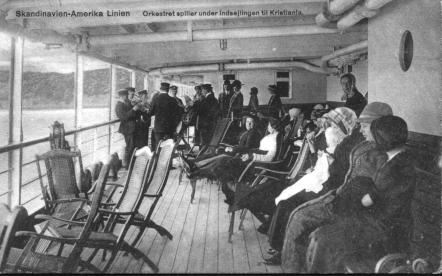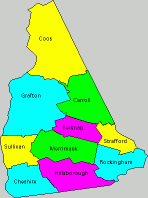

Swedes on their voyage to America
|
The Swedish Census 1890 Värmland |

Värmland Sweden |

New Hampshire |
(More on the early Nelsons as I acquire more information)
Nelsons in Berlin New Hampshire
The City is operated by a Mayor/Council/Manager form of government. It has a full-time fire department with about 26 men; and 23 full-time members on the police force. Two ambulances and a well-trained crew are on call 24 hours a day. Municipal water and sewer systems are available in all primary residential areas. There is weekly garbage collection and a new recycling center.
The first settlers came here for no apparent good reason. They were farmers and the land didn't promise to be any better here than what they had in Gilead and Shelburne down the river. But they were restless and independent and the tract of wilderness now known as Berlin was the last place on the Androscoggin River untouched by the plow. So they came across the mountains to start a new community in this isolated area.
They found a spectacularly beautiful, rugged land with a river running over rapids, chutes, and cascades for a full mile across the grain of the mountains and falling 400 feet, all in the space of six miles.
The Plantation of Maynesborough, as it was called, was named after the most illustrious of the English gentlemen to whom it was granted by the Crown in 1771. It was a hard place but no one had to go hungry for the woods were full of deer and partridge, and the brooks and river teemed with trout. And everywhere stretched the seemingly endless towering stands of timber-pine, spruce, fir, birch, and poplar, to name only a few.
Those first farmers who made the move from down river found good farmland upstream from the falls. There the river flowed calm and smooth through a valley that was wide enough to cultivate. William Sessions was the pioneer who opened five acres of land on the east side of the river in 1824 and came back in the spring of 1825 with his nephew to plant crops and build a log house.
Sessions did not stay long enough to see Maynesborough become established as the Town of Berlin; his nephew Cyrus Wheeler stayed, however. By 1829 there were seven families with names that are still remembered: Wheeler, Green, Thompson, Bean, Blodgett, Evans, Ordway, Cates. That year they incorporated their village under the name of the Town of Berlin, though it is not recorded why they chose that particular name. Over the next twenty years they and others who followed continued to farm the land, run sawmills, and raise homes and families.
In 1851, J.B. Brown and three other businessmen from Portland Maine formed a partnership under the name of H. Winslow & Co., and purchased the privilege at the top of the falls. They saw the making of a successful lumber business in the vast forest and natural water power of the river. They were also aware the railroad was coming to Berlin and that there would be a direct line of transportation to Portland and market centers for the first time. They would no longer have to make grueling trips through the hills hauling lumber by ox team or down the river by canal boats. The railroad would be sure and swift and a large scale lumber business could be profitable for the first time.
In 1852, H. Winslow & Co. began building their sawmill. They started operations in 1853, weathered a few bad years and then began to thrive. In 1868, William Wentworth Brown and Lewis T. Brown bought the controlling interest, establishing the Brown family in the lumber business. By then it was known as the Berlin Mills Company, the name it retained until 1917 when the business pressures caused the family to change the name to Brown Company.
The Brown Company grew rapidly and Berlin grew with it. Solely a lumbering outfit until 1888, by the end of the first decade of this century the Browns had the largest chemical pulp mill in the world (Burgess Sulphite) and what was known as the finest paper mill in the world (Cascade). Through careful management, intelligent expansion, and some governmental assistance during the Depression, the Brown Company, now known as the James River Corporation, is still a vital force in Berlin today.
In the early 1900's Berlin was a buzzing industrial center with a melting-pot population of nearly 12,000 people. The Browns weren't the only ones who realized the economic possibilities of the woods and river. H.H. Furbish, who perfected the soda process of making wood pulp, came to Berlin in 1877 and founded the Forest Fiber Company, which thrived until the development of the sulphite process in the pulp industry. The sulphite process utilized spruce wood which was less expensive than the poplar required by Forest Fiber's soda process. Furbish's enterprise could no longer compete by the turn of the century.
The Glen Manufacturing Company employed 500 people and was said to have the largest newsprint plant in the world; the Boston Globe and the New York Tribune among those with whom it held contracts. International Paper bought out the company and operated here until 1930, when the Depression seriously curtailed the paper industry and forced International to close the Berlin Mill.
Berlin's population numbered only 45 at the time of the Civil War, a total which increased gradually for the next 20 years, topping 1,000 by 1880. Then it boomed. There were almost 7,000 people living here by the turn of the century and nearly 12,000 by 1910. The city didn't stop growing until the early 1930's when the population reached a peak of over 20,000.
The growth of Berlin reflects the diversity of people who came to stay-French Canadians, Yankees from Northern New England farms, Norwegians, Italians, Irishmen, Russians. They sought a chance to make a better living and found it in the mills, blacksmith shops, machine shops, farms, stores, railroad yards and in the long winters' logging camps.
Some of them found it on the Androscoggin when the ice broke in the spring and the trees cut during the winter were driven down river to the mills. Each year they guided thousands of feet of timber down the Androscoggin from Errol, through the Thirteen-Mile Woods and Pontook and on to where piers built in the middle of the river separated logs belonging to one company from those of its competitor. The log drive has been replaced now by trucks and because of environmental concerns. The piers still stand, however as a silent reminder of those earlier days.
Among the things which have also disappeared are the farms, small sawmills, some of the big industries, a cranberry bog in the Dead River Swamp, streetcars, the Brown store, even the Browns themselves. Orton B. Brown, the last of William Wentworth Brown's sons, passed away in 1964.
In recent years Berlin's population has stabilized to around 12,000. The city has changed in size and appearance-buildings have been renovated and refurbished, new buildings have been built, Main Street is being revitalized and new small manufacturers and businesses have added to a new growing and prosperous Berlin.
[ History from Berlin High School Berlin , NH]